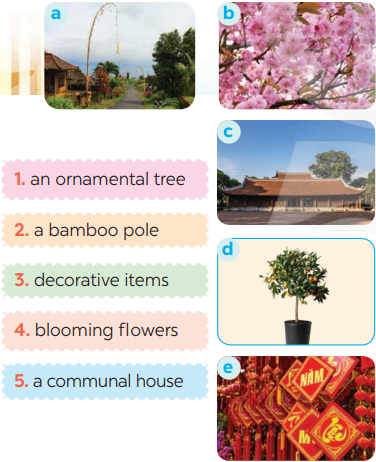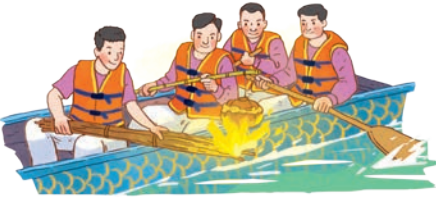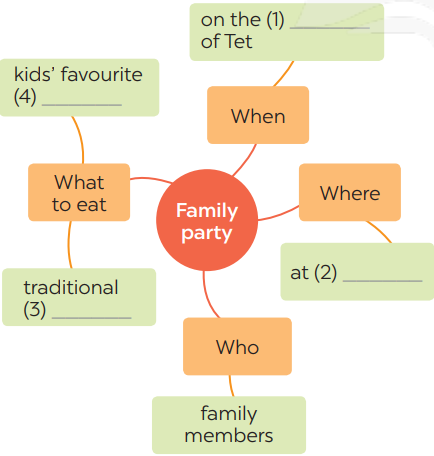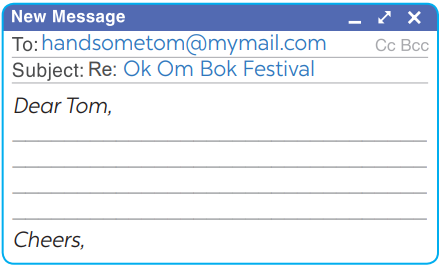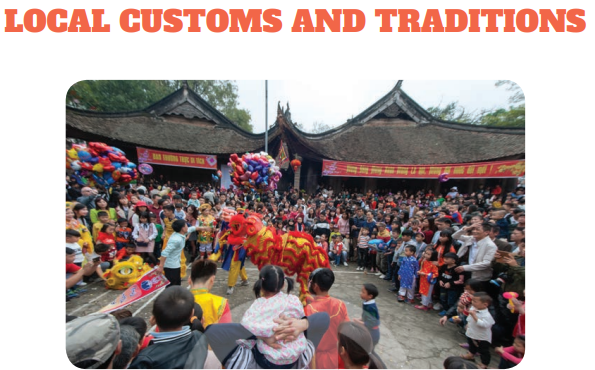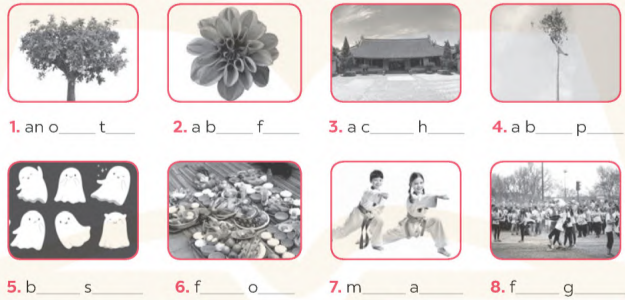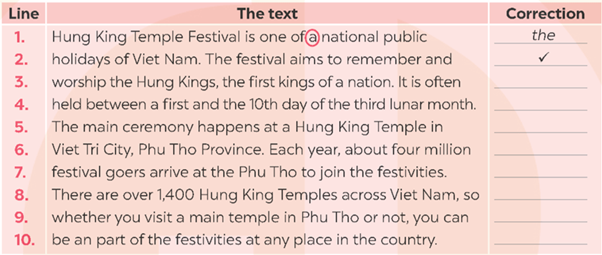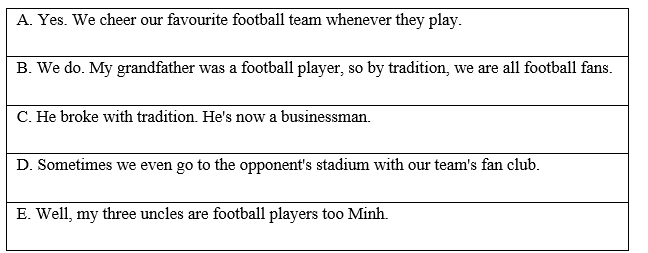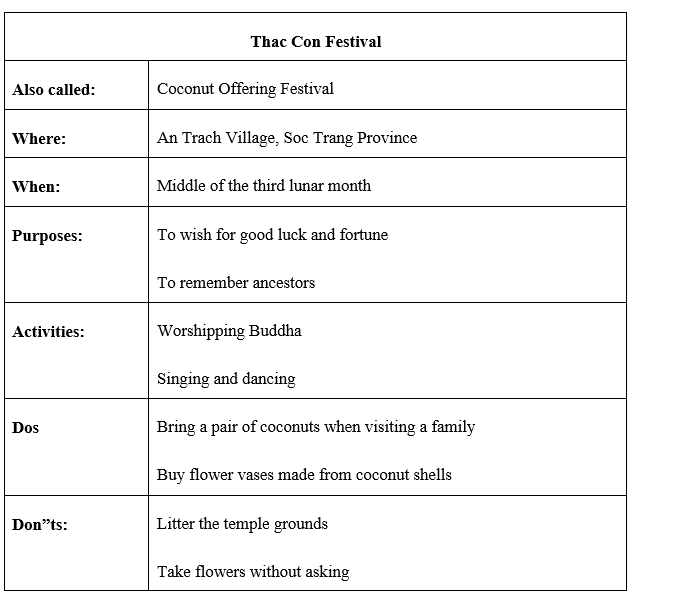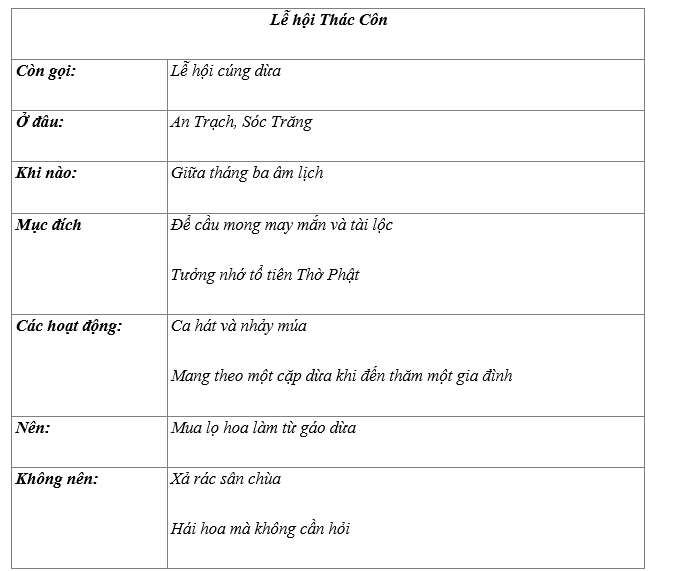Giải SGK, SBT Unit 5. Our customs and traditions Global Success
Giải SGK, SBT Unit 5 Global Success
2. Read the conversation again and tick (✓) T (True) or F (False).
(Đọc đoạn hội thoại lần nữa và đánh dấu (✓) T (True) hoặc F (Sai).)
|
|
T |
F |
|
1. Elena and Trang are at Sa Dec Flower Village. |
|
|
|
2. Many people visit flower villages to take photos. |
|
|
|
3. Trang’s family usually buys kumquat trees and peach blossoms at Nhat Tan Village. |
|
|
|
4. Flowers are not part of any Vietnamese traditions. |
|
|
|
5. People decorate bamboo poles with small bells and lanterns for New Years. |
|
|
4. Complete the sentences with the verbs from the box.
(Hoàn thành các câu với các động từ từ hộp.)
|
admire chase pray place |
1. The British decorate their Christmas trees and _____ presents under them.
2. Tomi likes to _____ the view from the hill.
3. In many cultures, knocking on wood is a way to _____ away bad spirits.
4. Many Asians go to Buddhist temples to _____ for good luck.
Vocabulary
1. Write a phrase from the box under each picture.
(Viết một cụm từ từ hộp dưới mỗi hình ảnh.)
|
wedding ceremony whale worship food offerings family reunion martial arts festival goers |
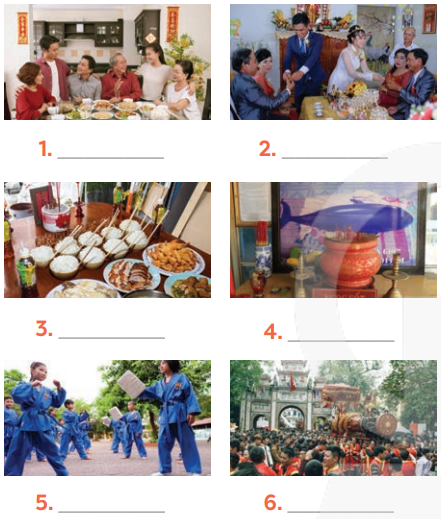
3. Complete the sentences with the words from the box.
(Hoàn thành các câu với các từ trong hộp.)
|
custom practise keep break traditionally |
1. This year, we will _____ with tradition and go on holiday instead of staying at home during Tet.
2. _____ children in the US go from house to house to ask for sweets on Halloween.
3. Holding a party to wish our grandparents longevity is one of the customs we _____ at Tet.
4. Organising a folk song club is one way for us to _____ our traditions alive.
5. It's becoming a _____ for young people to celebrate New Years in addition to Tet.
The Japanese lion dance and Vietnamese unicorn dance
(Múa sư tử của Nhật Bản và múa lân của Việt Nam)
3. Read the text about the lion dance in Japan and complete the table with the information from the text.
(Đọc văn bản về múa lân ở Nhật Bản và hoàn thành bảng với thông tin từ văn bản.)
The lion dance is called shishi-mai in Japanese. People perform it during New Year celebrations. Shishi-mai groups also perform at other important occasions such as business openings and weddings. Most forms of shishi-mai have one or more people performing the dance. The performers are excellent at acrobatics. One person controls the lion’s head and the other moves the lion’s body. The lion dances to the sounds of flutes and drums. The drummers and flute players often follow the lion around, but they do not dance with it.
The Japanese perform shishi-maito chase away bad spirits and to bring good luck.
|
Japanese lion dance |
|
|
Japanese name |
(1) _________ |
|
Occasions |
(2) _________ other important occasions |
|
Number of performers |
one or more |
|
Skills |
(3) _________ |
|
Dance partner |
no dance partner |
|
Musical instruments |
(4) _________ and drums |
|
Purposes |
to chase away (5) _________ to bring good luck |
4. Work in groups. Read Mai’s notes on the Vietnamese unicorn dance. Compare the Vietnamese unicorn dance with the Japanese lion dance.
(Làm việc nhóm. Đọc ghi chú của Mai về múa lân Việt Nam. So sánh múa lân Việt Nam với múa lân Nhật Bản.)
|
Vietnamese unicorn dance (Múa lân Việt Nam) |
|
|
Vietnamese name (Tên tiếng Việt) |
Mua lan (Múa lân) |
|
Occasions (Dịp) |
Mid - Autumn and New Year Festivals (Tết trung thu và Năm mới) Business openings and weddings (Khai trương kinh doanh và đám cưới) |
|
Number of performers (Số người biểu diễn) |
One or more (Một hoặc nhiều hơn) |
|
Skills (Các kĩ năng) |
Martial arts and acrobatics (Võ thuật và nhào lộn) |
|
Dance partner (Người múa cùng) |
Ong Dia (Ông Địa) |
|
Musical instrument (Nhạc cụ) |
drum (trống) |
|
Purpose (Mục đích) |
To wish for luck and success (Cầu mong may mắn và thành công) |
Example: (Ví dụ)
The Vietnamese unicorn dance and the Japanese lion dance are both popular on New Year Festivals.
(Múa lân của Việt Nam và múa sư tử của Nhật Bản đều phổ biến trong các dịp Tết.)
2. Listen to part of the programme “Charming Viet Nam”. Fill in each blank with no more than TWO words.
(Nghe một phần chương trình “Duyên dáng Việt Nam”. Điền vào mỗi chỗ trống không quá HAI từ.)
|
Ok Om Bok Festival |
|
|
Purposes (Mục đích) |
To thank the Moon God To mark the (1) _________ of the Khmer year |
|
Time (Thời gian) |
mid-October (lunar calendar) |
|
Offerings (Lễ vật) |
(2) _________ and fruits |
|
Activities (Các hoạt động) |
Singing and dancing Games and traditional (3) _________ Ngo Boat (4) _________ |
3. Listen again and tick (✓) T (True) or F (False).
(Nghe lại và đánh dấu (✓) T (True) hoặc F (Sai).)
|
|
T |
F |
|
1. Ok Om Bok is the Moon Worshipping Festival. (Ok Om Bok là lễ hội cúng trăng.) |
|
|
|
2. On the night of the festival, the elders talk about their wishes. (Vào đêm diễn ra lễ hội, những người lớn tuổi nói về những mong ước của họ.) |
|
|
|
3. There are lantern contests at the festival. (Có rất nhiều cuộc thi đèn lồng trong lễ hội.) |
|
|
|
4. Tourists should wear informal clothes when attending the worshipping ceremony. (Du khách nên mặc đồ bình thường khi tham dự lễ cúng.) |
|
|
3. Complete the text with the words from the box.
(Hoàn thành văn bản với các từ trong hộp.)
|
break custom traditionally maintain practise traditions |
I think each family has their own customs and (1) _______. For example, my uncle's children always spend two weeks in the countryside in summer time. Holding a party on everyone's birthday is another custom they (2)_______. As for my family, it is becoming a (3) ________ for us to bake a special cake on the last Sunday of each month. We also have a home cinema night every Saturday when we enjoy a film together. For my extended family, (4) ______ we gather on the first day of the Lunar New Year.
In my opinion, it is good for families to (5) ______ from time to time, they can (6) _______ their traditions. However, with tradition and try something new to add variety to their lives.
b. Match the information with the traditions. Some traditions can be used twice.
(Nối thông tin với truyền thống. Một số truyền thống có thể được sử dụng hai lần)
|
Information |
Traditions |
|
1. All participants sing a song at a specific time. 2. Lots of preparation happens before the event. 3. Participants have to wear a specific costume. 4. Piccadilly Circus is crowded at this time. 5. Participants race with a traditional food. |
A. Pancake race B. Christmas C. New Year Countdown |


